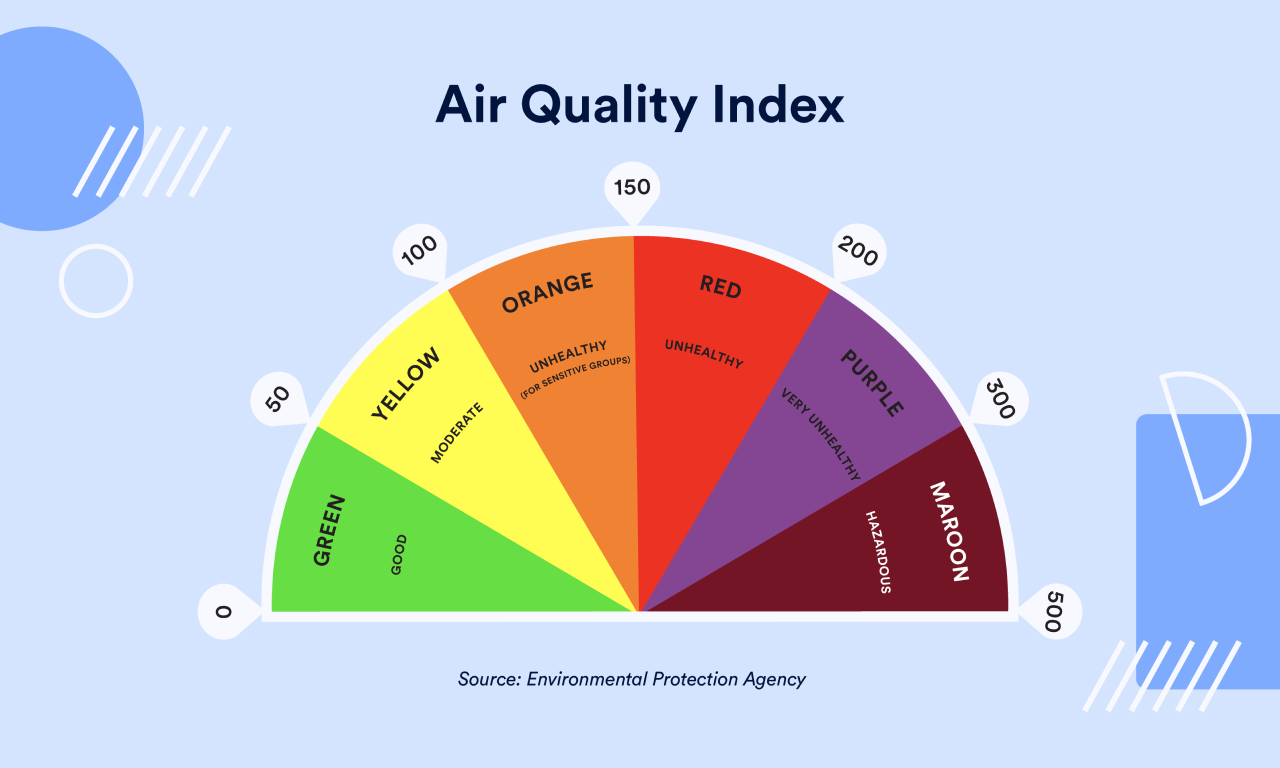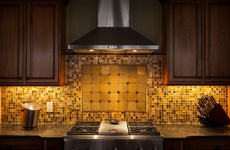How to test the air quality in your home

The Bankrate promise
At Bankrate we strive to help you make smarter financial decisions. While we adhere to strict , this post may contain references to products from our partners. Here's an explanation for .
With climate change and pollution continuing to impact weather and atmospheric conditions around the globe and the pandemic highlighting just how vulnerable humans are to invisible pathogens, many people are thinking harder about the air they breathe and how it could affect their health. Unfortunately, almost 36 percent of Americans – or 119.6 million people – are living in areas with unhealthy air, according to the American Lung Association’s State of the Air report for 2023.
While you can’t do much about the environment around you, one way to breathe easier is by measuring your home’s air quality — and improving it if needed. Here’s how you can test on your own, and what to know about getting professional help.
How is air quality measured?
You may be familiar with air quality warnings if you follow the local news or weather reports. The standard measurement for air quality is known as Air Quality Index, or AQI. On a large scale, ground and satellite instruments measure particles in the air, which are then scored from 0 (safest) to 500 (most dangerous). AQI primarily measures:
- Airborne particles
- Carbon monoxide
- Ground level ozone
- Nitrogen dioxide
- Sulfur dioxide
Ozone and airborne particles are the most common culprits, found as smoke from wildfires or smog. Air quality is color-coded depending on how concentrated the particles are. Air quality reports are often issued for a metropolitan area or region.

The higher the pollutant level, the less safe it is for people to be outside. If the results fall into the hazardous range, it is best to stay indoors, especially if you suffer from allergies or have respiratory or other health issues that make you sensitive to what you breathe. All the more reason to make sure your home’s interiors are safe to breathe in.
Why is it important to test the air quality in my home?
Breathing in polluted air can lead to many serious health problems, including respiratory issues, cardiovascular disease and cancer. Evaluating your home’s interior air and air flow is often the only way to know if there are pollutants present that could harm your health. While you may be able to spot mold and mildew in your home, some potentially deadly hazards (like radon and carbon monoxide) are colorless and odorless, so you likely wouldn’t even know that they’re even present — unless you test for them.
“Testing the air quality in our homes is an important step toward sleeping better, feeling better, and being healthier,” says Travis Blackburn, director, control systems marketing at AprilAire, a manufacturer of indoor air-quality products. “From invisible allergens and VOC gasses to humidity levels that are out of balance and a lack of fresh air, our homes have the potential to negatively impact our health and how we feel.”
What are the symptoms of poor air quality in a house?
There are a number of symptoms associated with poor air quality in your home, including:
- Visible mold or mildew
- Leaks or water-damaged ceilings
- Warped or buckled floors
- Dampness and humidity levels above 50 percent
- Strange or unexplainable odors
“If you find yourself dealing with things like sneezing, runny noses, headaches, static shock, an itchy throat, or dry skin and eyes – all of these can be symptoms of poor indoor air quality,” says Blackburn. “Poor air quality can also exacerbate allergy and asthma symptoms.”
How can you test air quality in your home?
There are several different kinds of air quality testing kits, typically designed to look for common toxins like radon, volatile organic compounds (VOCs), formaldehyde and carbon monoxide.
Knowing what to check for and how to test air quality in your home could save you time and money.
Digital air monitors
An air quality monitor can identify and alert you to an issue in its early stages. These devices use sensors to track the levels of specific pollutants and hazards, like radon, VOCs and formaldehyde.
There are many indoor air monitors available on the market, including the Airthings Wave Plus and the uHoo Smart Air Monitor. Alternatively, you can buy another type of smart device that has air quality monitoring functionality, such as a tech-enabled air purifier, smart thermostat or indoor home security camera.
“When it comes to knowing what to buy, make sure that your air quality monitor has precision, resolution, and calibration features,” suggests Sarah Jameson of Green Building Elements, an online information hub for construction projects. “Research the technology you are eyeing and check for its overall performance, including the range. Apart from your sensor being able to measure carbon monoxide, particulate matter, VOCs, humidity, formaldehyde, and radon, check reviews for how fast the response time for readings to come in, how well the sensor can be connected with smart technologies, and whether there is minimal noise.”
Mold tests
There are multiple kinds of mold tests, but only certain ones – including air pumps and petri dish tests – are designed to detect mold in the air. They work by taking samples of the air in your home, either through a collection cassette or a petri dish. After the collection period ends, you’ll need to send the samples to a lab to be analyzed.
Radon tests
Radon tests also come in different forms, from battery-powered test kits to single-use charcoal canisters to app-enabled plug-in devices. Some are designed for short-term use (between two days and three months), so you can identify issues quickly. Long-term tests are used for at least three months and can help you understand your home’s year-round radon levels.
Electronic radon tests continuously monitor radon levels in your home and notify you through an app or on-screen display, while one-time collection kits need to be sent into a lab.
Carbon monoxide detectors
Like smoke alarms, these devices track the amount of carbon monoxide in your home and make a loud noise if the levels get dangerously high. They’re available in hardwired, battery and plug-in models, either as standalone devices or with the ability to detect smoke or natural gas.
When should you hire a professional air quality service?
Although there are plenty of DIY options for air testing, they can be limited, particularly when it comes to one of the largest threats to a home’s air quality — mold.
“Homeowners who are not mold assessors cannot accurately test air quality,” Mike Powell, a Tampa, Fla.-based professional mold assessor at Red Flag Home Inspections explains. “DIY kits sold at big box stores confirm what any mold professional already knows: There’s mold everywhere.”
Mold often hides behind walls and under floors, making it more time-consuming (and expensive) to diagnose. It often starts in hard-to-spot places like basements — it loves the damp and the dark — and spreads through the home’s HVAC system. Not all molds are harmful, making it hard to pinpoint the presence of those causing real air-quality and health problems like lethargy, headaches or respiratory issues. A pro can make a more precise evaluation, identifying the types of mold in your home and your air — and to assess the degree of danger it represents.
“When collecting air samples, or testing that gets mold spores from the air in some way other than vacuum collection, an exterior/baseline sample should be collected,” notes Powell. “The mold spores you see in these results are not global and are not ‘known’ values. The way to assess an environment is to compare the indoor levels versus the outdoor levels in your area, which will vary wildly based on location. To take one without the other will leave them, and anyone thereafter, unable to make much use of the data.”
According to Angi, the average cost of a professional, whole-home air quality test is $436. The cost can vary based on home size. Such a test can diagnose allergens, asbestos, radon, carbon monoxide, harmful mold and VOCs. More detailed testing can be performed once the air-quality test results are in. Detailed testing is more expensive, costing an average of $500 for asbestos or radon and $300 to $1,000 for mold.
FAQs about testing air quality of your home
-
AprilAire’s Blackburn recommends that homeowners check their air quality at least once per year. For extra peace of mind, you can invest in an air quality monitor or smart device that continually tracks your air quality and alerts you if something isn’t right.
-
According to Angi, a professional air quality test usually costs between $291 and $585, depending on the size of your home. The average cost is $436.
-
It can. According to the Environmental Protection Agency (EPA), certain air purifiers can filter harmful gasses and particles from the air and possibly have a positive impact on health.
The bottom line on testing your home’s air quality
Your home should be your sanctuary — especially in these climate-challenged times — and maintaining pristine air quality can reduce your risk of health problems. Fortunately, there are plenty of tools to help. Start with an air-quality monitor which can continuously check your home’s air quality and alert you if carbon monoxide, formaldehyde, radon and VOCs are present. If something in particular is concerning you, you can test further using a DIY kit for the indoor pollutant or call in a professional to help identify the issue — and fix it, before it gets worse.
Related Articles



